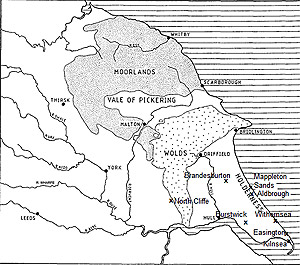Mammoth and extinct straight-tusked elephant (Elephas palaeoloxodon antiquus) remains from the Upper Pleistocene, usually fossilised teeth, are not that uncommon, particularly along the North Sea coast of Holderness.

Mammoth and other ancient elephant finds In Yorkshire. 16 mammoth finds locations
Again in 2009, a piece of mammoth tooth was discovered at Kilnsea, also now on display at Spurn Point, and a mammoth tooth from Spurn Point was donated to Hull Museum in 1907.
The museum currently has a collection of 22 further certified assorted elephant/mammoth remains from Devensian deposits, principally tills (boulder clays) or gravel pits, of which 15 are teeth (molars) and 7 are tusks. Of the 15 teeth, 9 are specifically identified as Woolly Mammoth (Mammuthus primigenius); of the 7 tusks, 5 are specifically assigned to the Woolly Mammoth. 8 of the remains carry provenance, particularly those from inland sites with recorded stratigraphy and geology: 3 come from the Brandesburton gravels, 1 each from the foreshore at Aldbrough, the Kelsey Hill gravels at Burstwick, Easington, the cliff face at Kilnsea, and Withernsea. In addition, Hull museum holds as many remains again from the Holderness area of uncertain identity simply recorded as Elephas sp.
A Woolly Mammoth tusk found at Withernsea in 1993 is on display in the town. In July 2004 a set of teeth were exposed on the beach at Mappleton Sands between Mappleton and Great Crowden after a storm followed in September of the same year by a piece of tusk, both reliably reported as Woolly Mammoth: the finds were later put on display at Hornsea Museum. Several Upper Pleistocene faunal finds, including mammoth, come from Bielsbeck, near North Cliffe, south of Market Weighton.